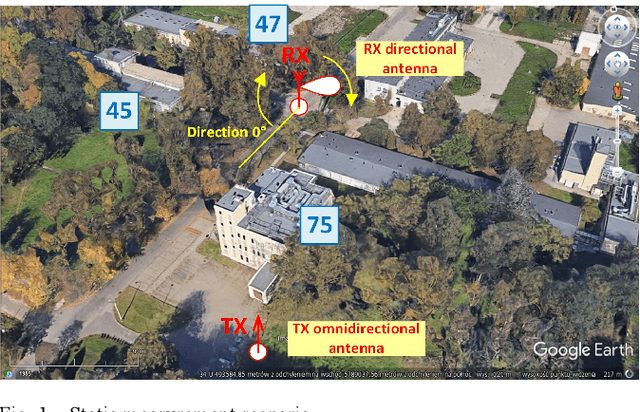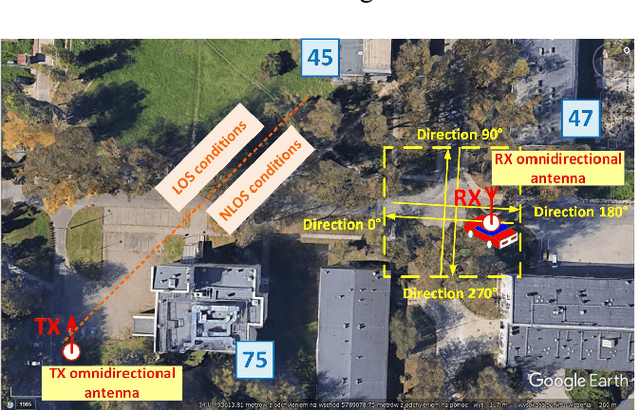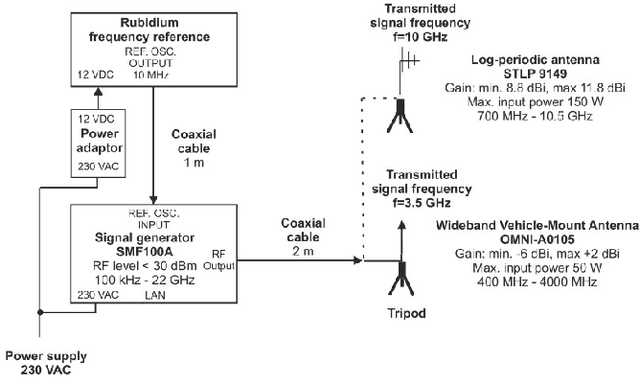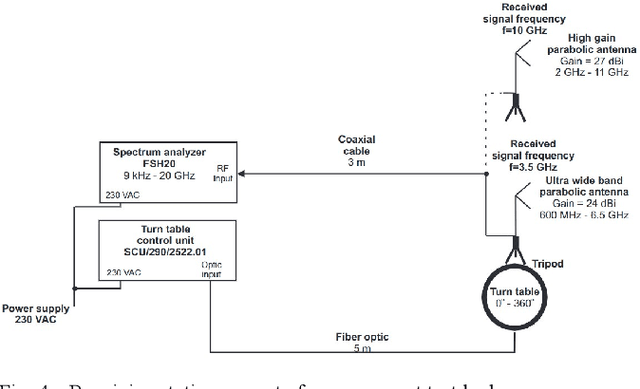Anirban Ghosh
Vehicle to vehicle path loss modeling at millimeter wave band for crossing cars
Mar 24, 2025Abstract:Fifth generation (5G) new radio is now offering sidelink capability, which allows direct vehicle-to-vehicle (V2V) communication. Millimeter wave (mmWave) enables low-latency mission-critical V2V communications, such as forward crash warning, between two vehicles crossing on a road without dividers. In this article, we present a measurement-based path loss (PL) model for V2V links operating at 59.6 GHz mmWave when two vehicles approach from opposite sides and cross each other. Our model outperforms other existing PL models and can reliably model both approaching and departing vehicle scenarios.
* 5 pages, 4 figures, 2 tables
Synthesis of omnidirectional path loss model based on directional model and multi-elliptical geometry
Mar 18, 2025Abstract:Millimeter wave (mmWave) technology offers high throughput but has a limited radio range, necessitating the use of directional antennas or beamforming systems such as massive MIMO. Path loss (PL) models using narrow-beam antennas are known as directional models, while those using omnidirectional antennas are referred to as omnidirectional models. To standardize the analysis, omnidirectional PL models for mmWave ranges have been introduced, including TR 38.901 by 3GPP, which is based on measurements from directional antennas. However, synthesizing these measurements can be complex and time-consuming. This study proposes a numerical approach to derive an omnidirectional model from directional data using multi-elliptical geometry. We assessed the effectiveness of this method against existing PL models for mmWaves that are available in the literature.
* 5 pages, 5 figures, 2 tables, 1 algorithm, 10 equations
Power angular spectrum versus Doppler spectrum -- Measurements and analysis
Mar 16, 2025



Abstract:In this paper, we present an empirical verification of the method of determining the Doppler spectrum (DS) from the power angular spectrum (PAS). Measurements were made for the frequency of 3.5 GHz, under non-line-of-sight conditions in suburban areas characteristic of a university campus. In the static scenario, the measured PAS was the basis for the determination of DSs, which were compared with the DSs measured in the mobile scenario. The obtained results show that the proposed method gives some approximation to DS determined with the classic methods used so far.
* 5 pages, 7 figures, 1 table, 8 equations; 2023 17th European Conference on Antennas and Propagation (EuCAP), Florence, Italy, 26-31 Mar. 2023
Spectral efficiency for mmWave downlink with beam misalignment in urban macro scenario
Mar 16, 2025Abstract:In this paper, we analyze the spectral efficiency for millimeter wave downlink with beam misalignment in urban macro scenario. For this purpose, we use a new approach based on the modified Shannon formula, which considers the propagation environment and antenna system coefficients. These factors are determined based on a multi-ellipsoidal propagation model. The obtained results show that under non-line-of-sight conditions, the appropriate selection of the antenna beam orientation may increase the spectral efficiency in relation to the direct line to a user.
* 4 pages, 6 figures, 4 equations; 2024 4th URSI Atlantic Radio Science Meeting (ATRASC), Meloneras, Spain, 19-24 May 2024
Variability of radio signal attenuation by single deciduous tree versus reception angle at 80 GHz
Mar 16, 2025



Abstract:Vegetation significantly affects radio signal attenuation, influenced by factors such as signal frequency, plant species, and foliage density. Existing attenuation models typically address specific scenarios, like single trees, rows of trees, or green spaces, with the ITU-R P.833 recommendation being a widely recognized standard. Most assessments for single trees focus on the primary radiation direction of the transmitting antenna. This paper introduces a novel approach to evaluating radio signal scattering by a single deciduous tree. Through measurements at 80 GHz and a bandwidth of approximately 2 GHz, we analyze how total signal attenuation varies with the reception angle relative to the transmitter-tree axis. The findings from various directional measurements contribute to a comprehensive attenuation model applicable to any reception angle and also highlight the impact of bandwidth on the received signal level.
* 5 pages, 5 figures, 1 table, 7 equations; 2025 19th European Conference on Antennas and Propagation (EuCAP), Stockholm, Sweden, 30 Mar.-4 Apr. 2025
THz Channels for Short-Range Mobile Networks: Multipath Clusters and Human Body Shadowing
Dec 18, 2024Abstract:The THz band (0.1-10 THz) is emerging as a crucial enabler for sixth-generation (6G) mobile communication systems, overcoming the limitations of current technologies and unlocking new opportunities for low-latency and ultra-high-speed communications by utilizing several tens of GHz transmission bandwidths. However, extremely high spreading losses and other interaction losses pose significant challenges to establishing wide-area communication coverage, while human body shadowing further complicates maintaining stable communication links. Although point-to-point (P2P) fixed wireless access in the THz band has been successfully demonstrated, realizing fully mobile and reliable wireless access remains a challenge due to numerous issues to be solved for highly directional communication. To provide insights into the design of THz communication systems, this article addresses the challenges associated with THz short-range mobile access networks. It offers an overview of recent findings on the environment-dependence of multipath cluster channel properties and the impact of human body shadowing, based on measurements at 300 GHz using a double-directional high-resolution channel sounder and a motion capture-integrated channel sounder.
MLPerf Power: Benchmarking the Energy Efficiency of Machine Learning Systems from μWatts to MWatts for Sustainable AI
Oct 15, 2024



Abstract:Rapid adoption of machine learning (ML) technologies has led to a surge in power consumption across diverse systems, from tiny IoT devices to massive datacenter clusters. Benchmarking the energy efficiency of these systems is crucial for optimization, but presents novel challenges due to the variety of hardware platforms, workload characteristics, and system-level interactions. This paper introduces MLPerf Power, a comprehensive benchmarking methodology with capabilities to evaluate the energy efficiency of ML systems at power levels ranging from microwatts to megawatts. Developed by a consortium of industry professionals from more than 20 organizations, MLPerf Power establishes rules and best practices to ensure comparability across diverse architectures. We use representative workloads from the MLPerf benchmark suite to collect 1,841 reproducible measurements from 60 systems across the entire range of ML deployment scales. Our analysis reveals trade-offs between performance, complexity, and energy efficiency across this wide range of systems, providing actionable insights for designing optimized ML solutions from the smallest edge devices to the largest cloud infrastructures. This work emphasizes the importance of energy efficiency as a key metric in the evaluation and comparison of the ML system, laying the foundation for future research in this critical area. We discuss the implications for developing sustainable AI solutions and standardizing energy efficiency benchmarking for ML systems.
 Add to Chrome
Add to Chrome Add to Firefox
Add to Firefox Add to Edge
Add to Edge